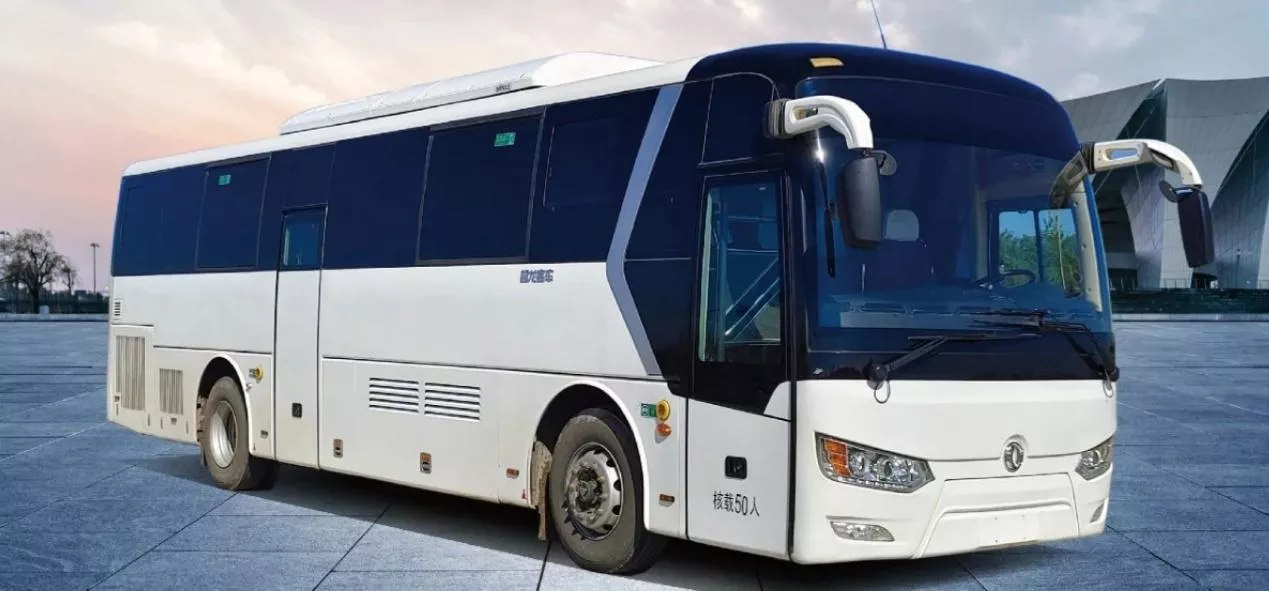Under the backdrop of global energy transition and “dual-carbon” strategy, hydrogen fuel cell technology is becoming an important development direction in the field of commercial vehicles. Relying on its profound technical accumulation, Dongfeng Special Vehicle Co., Ltd. has launched a series of hydrogen fuel cell buses with completely independent intellectual property rights, and through a number of technological innovations, it has provided brand-new solutions for the development of China’s hydrogen energy transportation.
I.Powertrain core technologies
Dongfeng SVB Hydrogen Fuel Cell Bus is equipped with a self-developed DFAC-FCS300 fuel cell system, which adopts graphite bipolar plate technology, with a rated power of 120kW and a peak power of 150kW. the system realizes performance breakthroughs through several technical innovations:
- The electrostack adopts a multi-channel serpentine flow field design, which increases the hydrogen utilization rate to 99.5% and reduces the air stoichiometry ratio to 1.8, significantly reducing the energy consumption of auxiliary engines. The system integrates self-heating start-up technology, realizing unassisted cold start at -30℃ and controlling the start-up time within 90 seconds. Adopting an anti-reverse polarity catalyst and an enhanced proton exchange membrane, the durability of the system is more than 25,000 hours under dynamic working conditions.
- The system highly integrates key auxiliary machines such as air compressors and hydrogen circulation pumps, reducing the number of parts by 30% and the failure rate by 45%. Intelligent multi-objective coordinated control strategy keeps the system efficiency above 55% in the range of 30%-100% load.

II.Energy management systems
It adopts a “fuel cell + lithium battery” hybrid power scheme, equipped with an 80kWh high-power lithium battery pack, and realizes intelligent switching of three working modes. A closed-loop management system has been developed from hydrogen storage, hydrogen supply to exhaust gas treatment, and a real-time energy management algorithm based on road condition prediction can optimize power distribution according to line parameters.
In the Wuhan bus test, the strategy reduces the hydrogen consumption of the whole vehicle to 5.8kg/100km (12-meter model), and the range exceeds 600km. The system is intelligently adjusted to ensure optimal performance under different operating conditions.
III. Security protection system
The hydrogen storage system adopts Type IV 70MPa carbon fiber winding hydrogen storage cylinder, which has passed 15,000 pressure cycle tests. It is equipped with three levels of safety protection: a temperature-activated pressure relief device integrated in the mouth of the cylinder, a solenoid valve and a manual shut-off valve in the pipeline, and an on-board hydrogen concentration sensor with an accuracy of 0.1% vol.
In terms of collision safety design, the hydrogen storage system is arranged in the protection zone of the roof impact beam, and the collision transmission path is optimized through CAE simulation. In the frontal crash test, the integrity of the hydrogen system was maintained for more than 300ms, and a five-stage hydrogen safety prevention and control system has been developed, forming a complete closed loop from detection to processing.

IV.Complete Vehicle Performance
Key performance parameters show that the model has a maximum range of 650km (working condition method), hydrogen refueling time of only 8-10 minutes (35MPa), hydrogen consumption of 5.8kg/100km (12m model), and 25,000 hours of electric reactor life.
In actual operation, the 20 vehicles demonstrated in Zhengzhou have accumulated more than 2 million kilometers of operation, with an average daily driving speed of 380km, an average hydrogen consumption of 6.2kg/100km, and an inter-failure mileage of 15,000km.
V.Direction of technological development
The next generation of products being developed by Dongfeng Special Truck will realize three breakthroughs: the adoption of metal bipolar plate technology to improve power density, the development of a solid-state hydrogen storage system to improve the density of hydrogen storage, and the construction of a “vehicle-station-cloud” hydrogen Internet of Things to realize intelligent scheduling. These innovations will further promote the commercialization of hydrogen fuel cell buses.
Through independent technological innovation, Dongfeng Special Truck and Bus has built a complete technology chain, which provides a reliable solution for the commercialized operation of hydrogen buses. With the continuous iteration of technology, Dongfeng Special Truck is leading China’s hydrogen fuel cell buses towards a new stage of large-scale application.


